Forestry commission urges vigilance amid rising brush, wildfires
Published 2:32 pm Friday, March 22, 2024
By Haley Mitchell Godwin
In the initial months of 2024, the Alabama Forestry Commission and local volunteer fire departments have been battling an unanticipated upsurge in brush fires and wildfires throughout the county. Late winter usually brings elevated humidity, reduced wind and increased ground moisture, acting as natural barriers against wildfire propagation. However, January presented a stark contrast, and while February and March managed to restore Crenshaw County’s drought index to typical levels, authorities emphasize the need for year-round vigilance.
Ethan Barrett, a fire analyst with the Alabama Forestry Commission, highlighted the concerning statistics in a Feb. 27 interview.
“In the past five days, forestry commission’s seen 250 fires, which is odd for this time of year to have this type of a spike and we’ve suppressed 9,700 acres,” said Barrett.
According to Barrett, one of the critical factors contributing to the escalation of wildfires is the absence of nighttime humidity, which typically aids in keeping the ground damp. This lack of moisture prolongs the susceptibility of the terrain to ignition, resulting in fires that can grow rapidly and spread unpredictably.
Scott Stricklin, President of the Crenshaw County Association of Volunteer Fire Departments and Crenshaw County E911 director, shared some statistics regarding the increased fires, stressing the indispensable role and collaboration of volunteer fire departments and the Alabama Forestry Commission in wildfire suppression efforts.
“For the last quarter of 2023 (October – December) fire departments responded to 28 wildland fire calls,” Stickland said. “In January of this year there were 11 responses and in February it jumped to 34 responses for that one month alone.”
Community Engagement For Prevention
Harrison Weed, chief of Bullock Community Volunteer Fire Department, stressed the collective responsibility in preventing wildfires, urging vigilance and caution in outdoor activities. Weed requested individuals promptly report any out-of-control fires to emergency services.
“Although a recent surplus of rain has certainly helped things, dry conditions and high winds in January and February played a role in the increased number of wildfires we have responded to lately,” Weed said. “It takes diligence from everyone to prevent wildfires, year-round diligence. Please make sure outdoor fires are contained if it is necessary to burn, make sure to secure chains on trailers or trucks to prevent throwing sparks into dry grass and please be weary of where you discard cigarette butts. If you spot a fire that appears to be burning out of control or without proper supervision, please dial 911.”
Call for vigilance, reporting
Elliot Jones, Director of Crenshaw County Emergency Management Agency, emphasized the criticality of brush fire and wildfire safety in safeguarding environments, homes and communities. Jones stated that strict adherence to brush fire safety measures, such as maintaining clear boundaries around properties, proper disposal of agricultural waste and adherence to local fire regulations including obtaining a burn permit, when necessary, is essential to prevent these catastrophic consequences and protect our vital land resources.
“When brush fires or wildfires occur, the impacts on wooded, pasture, and farmland areas can be devastating,” Jones said. “In pasture lands, brush fires can destroy large expanses of grazing land, negatively affecting livestock by reducing food resources and causing potential harm through direct exposure to flames. For farmlands, the impact is equally dire; brush fires can obliterate crops in minutes, leading to significant economic losses for farmers and communities.”
Proactive Measures for Protection
The Alabama Forestry Commission has outlined several proactive measures that landowners can take to mitigate the risk of wildfires:
- Install Firebreaks: Construct and maintain firebreaks around forest perimeters to prevent the ingress of fire onto your property. Interior firebreaks aid in containment and facilitate wildfire suppression efforts.
- Prescribed Burns: Controlled burns are an effective method for reducing hazardous fuels, thereby minimizing the impact of wildfires. Landowners are encouraged to become certified burn managers or seek assistance from certified service providers.
- Hazardous Fuel Reduction: Remove combustible vegetation along roadways and property entrances to minimize the risk of arson fires. Clearing scrubby vegetation and maintaining a defensible space enhances property aesthetics and reduces wildfire risk.
- Limit Access: Install barriers to restrict unauthorized access to property, minimizing the risk of arson, vandalism and other malicious activities. Reporting suspicious behavior to the arson/forest crimes hotline aids in wildfire prevention efforts.
- Community Collaboration: Engage with local volunteer fire departments and wildfire protection initiatives to bolster community resilience against wildfires.
To mitigate the risk of wildfires, individuals are encouraged to apply for burn permits through the Alabama Forestry Commission by calling 1-800-392-5679. Further information and resources on wildfire safety can be found on the commission’s website at www.forestry.alabama.gov.








